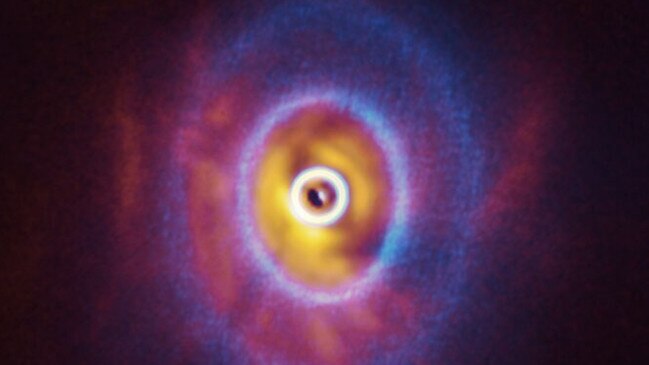In a system far, far away a planet forms with three suns
1,300 light years away spins a solar system that could give Luke Skywalker’s home planet of Tatooine a run for its money.

It is one of the most celebrated scenes in science fiction: a young Luke Skywalker gazes wistfully into the heavens of his home planet of Tatooine, where two suns are setting.
Now a team of astrophysicists have provided the clearest glimpse yet of how such worlds form in reality. The research focuses on a trio of stars about 1,300 light years away in a system called GW Orionis, in the constellation of Orion.
They are surrounded by an immense disc of dust – the raw material for new planets – and scientists believe the conditions are right to create a world rather like Tatooine, which appeared in Star Wars, although this one would have three “suns” rather than two.
Stefan Kraus, a professor of astrophysics at Exeter University, who led the research, said: ” ‘Tatooine’ planets that orbit around two or three suns have been envisioned by science fiction and some have been detected – here, we observe how they form.”
During the 18th century, the idea took hold that planets are created in neatly arranged flat discs of dust around young stars. Around GW Orionis, however, the disc is not flat, but warped. A distinct inner ring of dust, containing enough matter to form 30 Earths, has broken away from the disc and is tilted at a sharply oblique angle. This, the researchers say, is a promising nursery for the creation of “Tatooine” planets.
The three stars in the centre of the system move in an intricate dance. Two pirouette around each other while also moving as a pair in an ellipse. They are separated by about 145 million kilometres, roughly the distance between the Sun and Earth. The third star circles around its spinning siblings once every 11 years at a distance of about 720 million miles.
By tracing these stellar orbits the researchers were able to deduce, using computer simulations, how the stars’ gravitational pull came to warp the disc of dust and how the misaligned inner ring broke away.
Planets that formed in the inner ring or in the outer disc of dust would have three “suns”. They would be at least 46 times further from their stars than the Earth is from our Sun. This would probably make them “ice worlds”.
However, the study also detected another patch of dust close to the stars, in a region where liquid water might exist. “Planets might have formed [here] as well and could be on very exotic orbits,” Professor Kraus said.
They may, for instance, weave in between the stars.
Such worlds would experience extreme swings in temperature. Alexander Kreplin of Exeter University, a co-author of the study, said that because more than half of stars were born with one or more companions, the kind of environment around GW Orionis could be relatively common.
The view would beat even Luke Skywalker’s. “One would see not only the three stars dancing around each other at different speeds, but also a massive dust ring extending over the whole firmament,” Professor Kraus said.
“Half of the sky would be covered by a massive warped disc that is illuminated by the three stars, interrupted by narrow shadows, cast by the misaligned disc ring. I find it fascinating to imagine how the sky would look like from any planet in such a system.”
The study is published in Science.
The Times



To join the conversation, please log in. Don't have an account? Register
Join the conversation, you are commenting as Logout